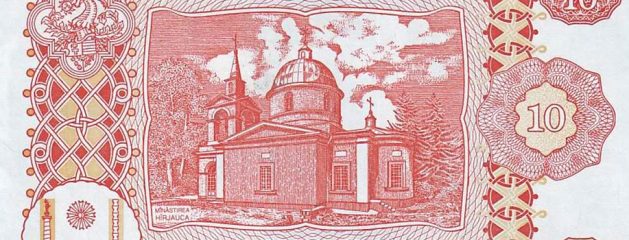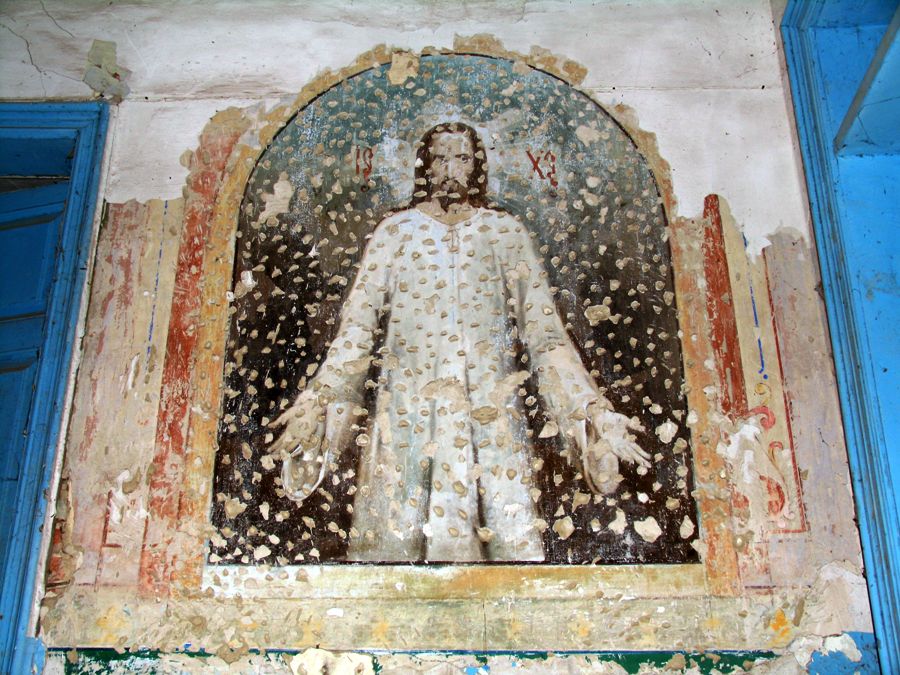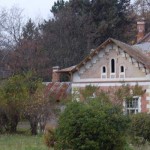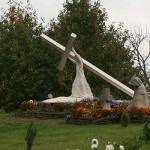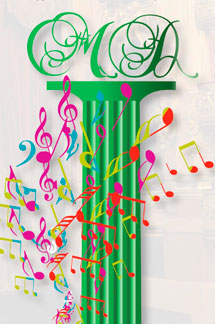Мужской монастырь Харжаука найти не так-то просто: нужно точно иметь представление, где свернуть с трассы Кишинев-Унгены. То, что это «где-то под Каларашом», мы знали. Но указатели отсутствуют, и мы намотали лишние километры. Если б раньше были в курсе, что вплотную к монастырю прилегает санаторий «Кодры», нашли бы святую обитель быстрее.
Кстати, санаторий – тоже местная достопримечательность. Сохраненный с советских времен, он смог выжить, и теперь принимает сотни людей каждый месяц. И ведь не зря санаторий «прилип» к монастырю: места здесь красивейшие. В общем, Кодры (молдавский лес).
Когда здесь появился скит, примерно в 1740-м году, ни о каких санаториях речь не шла. Но место выбрали такое, где любой способен был излечиться от хвори, будь то хворь физическая или духовная. И сегодня здесь находится известный «источник молодости». Говорят, водичка в нем обладает целебными свойствами.
В сборнике «Бессарабия» (1903 год издания) монастырь называют «Гиржавским Вознесенским». Автор явно восхищен видом обители. Он описывает сады и виноградники, окружавшие монастырь. А внутри сада – фонтаны, павильоны, беседки, от которых идут чистые дорожки к прудам, «висящим один над другим».
Назвали монастырь «Гиржавским» по имени ручья Гиржавки. А вот версий возникновения на этом месте святой обители несколько. Одна из них гласит о том, что долина возле ручья часто служила местом спасения от набегов татар. Там и был построен поначалу скромный молитвенный дом. Когда опасность набегов миновала, местные вернулись по своим деревням, а в молитвенном доме остался старец Феодосий. Тянуло его к отшельнической жизни. Чуть позже к нему присоединился иеромонах из Нямецкой лавры Варсонофий с монахом. Тогда Феодосий постригся в монахи под именем Феоктиста. Он и еще три инока с помощью боярина Никулицы построили первые кельи, а на месте молитвенного дома – церквушку. Все постройки были из дерева. Когда слух о новой обители разнесся по округе, иноки стали приходить и приходить в скит. Феоктист стал начальником. А перед смертью отписал монастырю свое небольшое имение в вотчинах Сипотены и Калараш.
По другой версии, монастырь был открыт в 1750-м году монахом Иннокентием Севым. По преданию, этот монах родился в селе Калараш (в настоящее время – город, районный центр), а получил постриг в Яссах (Румыния). Монастырю он отписал участок земли Сипотенской вотчины. Землю монастырю подарил и дядя Иннокентия – Мирон Бидюк. Внуки последнего – Василий и Урсу – тоже монастырь жаловали. В 1811 году они утвердили дар своих предков, да еще отдали земли возле Гиржавки.
В начале 19-го века молодой монастырь переживает не лучшие времена. Он разграблен и разрушен турками и татарами. Такое хозяйство досталось архимандриту Спиридону Филиповичу: он сменил на посту управляющего обителью Тарасия. Сам Спиридон – черногорец, рано стал монахом, и, покинув родину, долго скитался. Видел перевороты и смуту. В 1818 году он осел в Бессарабии, решив взяться за обустройство монастыря в Гиржавке. Он поселил на монастырской земле крестьян, разбил сады, занялся хлебопашеством и скотоводством. В 1836 году построил теплую церковь и кельи. На месте старого деревянного храма Спиридон возвел каменную Вознесенскую церковь.
В 1845 году монастырь поступает в управление кишиневской епархии. Гиржавку полюбил бывший архиепископ кишиневский и хотинский Иринарх — он многое изменил в обители: перестроил почти все здания, закончил возведение церкви во имя святого Спиридона Тримифийского. А чуть позже, благодаря заботам о Гиржавке высокопреосвященных Павла и Исаакия, в обители были возведены каменные настоятельские кельи при церкви и покои с 7 отделениями. В монастыре была своя пекарня, 7 корпусов для монахов, конюшня, сараи и амбары. Обитель обнесли высоким каменным забором. Монастырь славился огромной богатой библиотекой и школой.
Именно таким, каким монастырь был в середине и конце 19-го века, он сохранился и до наших дней. Правда, все здания требовали ремонта: кое-что уже отреставрировано. Кое-что еще нуждается в перестройке.
В советские времена обитель закрыли: здесь был санаторий. А в 1993 году опять поселились монахи.
Чтобы проехать в обитель, мы въезжаем в ворота санатория «Кодры», минуем автомобильную стоянку, и оказываемся у оригинального источника, того самого, с целебной водой, которая льется прямо из ствола дерева. В монастыре – никого. Нас встречает косуля, видно, спасли ее монахи. В центре обители, перед церковью, — оригинальный фонтан. А по периметру монастыря – кельи. Добротные, старой постройки. Находим скрытую калитку в высоком заборе монастыря, и оказываемся в лесу. Вряд ли так и было лет 150 назад: бутылки и бумажки, костровища, — видно, любят здесь отдыхающие в санатории пикники организовывать. А в монастыре за забором – все по-другому: чисто и тихо. Как будто две разные планеты: чистая, тихая и грязная, суетливая. Так и живем. По разные стороны забора.
Наталья Синявская
English version
For Youth –to the Harjauca Monastery
It is not easy to find the Harjauca Monastery: you need to precisely know the place to turn off the highway Chisinau-Ungheni. The fact of its being “somewhere near Calarasi town” was familiar to us. But there was no indicator and we drove some additional kilometres. If we had known in advance, that next to the monastery there stands the health resort “Codry”, then we would have found the sacred cloister faster.
By the way, the health resort is also a local sightseeing place. Preserved from the soviet times, it has managed to survive and nowadays accepts hundreds of visitors monthly. And the health resort has “stuck” to the monastery not in vain: the landscape is fascinating. The place is mostly covered by the Codry (the Moldovan forest).
When the cloister appeared here, about the year 1740, no health resort was thought about. But the place has been selected so that everyone could heal from disease be it physical or spiritual. And now a famous “spring of youth” is located here. Its waters are said to possess healing powers.
The collection of articles “Basarabia” (published in 1903) names the monastery as “The Harjauca Monastery of the Ascension”. The author seems to have been truly astonished at the appearance of the cloister. He describes orchards and vineyards surrounding the monastery. And inside the orchard there are fountains, pavilions, pergolas, from which there stretched clean paths to the ponds “hanging one after the other”.
The Monastery has got its name after the name of the Harjauca stream. And as to the versions of the monastery establishment, there are several of them. One of such versions states then the valley near the stream served the place to escape from raids of the Tatar. This place was first elected to construct a modest house for praying. When the threat of raids passed by, the local dwellers returned in their villages, and in the house there settled the old Feodosy. Reclusive life attracted him. A bit later the old was joint by celibate priest Varsonofy from the Neametskaya Lavra and one more monk. Then Feodosy accepted the monkhood under the name of Feoktist. He together with three more monks with the help of the boyard Niculitsa constructed the first sells and a church at the place of the house for praying. All constructions were wooden. When the news about the new cloister spread around the area, more and more monks came to the cloister. Feoktist became the father superior. And before his death he transferred to the monastery all his minor estate in the districts Sipoteni and Calaras.
According to the other version, the monastery was opened in the year 1750 by the monk Innokenty Sevy. According to the legend, this monk was born in Calaras settlement (at present this is a city and the regional centre), and accepted monkhood in Iasi (Romania). He allotted to the monastery a land plot in the Sipoteni district. Innokenty’s uncle – Myron Biduk – also presented a land plot to the monastery. The grand sons of the latter – Vasily and Ursu – honoured the monastery as well. In the year 1811 they confirmed the donation of their ancestors and even added land near Harjauca.
At the beginning of the 19th century the young monastery witnessed not the best times. It was plundered and destroyed by the Turks and the Tatars. Such heritage was taken up by the by the archimandrite Spiridon Philipovich: he replaced the superior of the cloister Taracy. Spiridon himself, a Montenegrin, early adopted the monkhood, and after leaving the motherland was wandering a lot. He saw coups and unrests. In 1818 he settled in Basarabia making his mind to take over restoration of the Monastery in Harjauca. He settled the peasants onto the monastery land, established orchards, started arable farming and cattle breeding. In the year 1836 he constructed warm church and cells. On the place of the old wooden temple erected Spiridon a stone churched consecrated after the Day of Ascension.
In the year 1845 the monastery got under supervision of the Chisinau Eparchy. The Harjauca Monastery was liked by the former archbishop of Chisinau and Hotin Irinarh – he changed a lot in the cloister: reconstructed almost all buildings, finished erection of the church in the name of the Saint Spiridon Trimfiisky. And a bit later due to the care of their Eminences Pavel and Issaaky about Harjauca, the cloister saw stone cells for the superior next to the church and the premises with 7 departments erected. The monastery had its bakery, 7 houses for monks, a stable, sheds and barns. The cloister was surrounded by high stone fence. The monastery was famous due to its large rich library and school.
Exactly the way as the monastery existed in the middle and the end of the 19th century, it preserved and now. Although, all buildings were in need of repair: something has already been repaired. Still something needs to be reconstructed.
In the soviet times the cloister was closed: a health resort was placed here. And in the year 1993 the monks settled here again.
In order to get to the cloister we enter the gates the “Codry” health resort, pass by an auto parking and find ourselves near an original spring, the very one with the healing water, which pours straight out of a tree trunk. There is nobody in the monastery. We are met by a roe-deer, which must be saved by the monks. In the centre of the cloister, in front of the church there is an original fountain. The cells are place on the monastery’s perimeter. The all are durable of old construction. We find a hidden gate in the fence of the monastery and are already in the forest. Things must not have been in such order 150 years ago, as we see them: bottles and paper-wraps, fire bases – the health resort visitors are sure to like making barbeque here. And the monastery behind the fence knows other order: everything is clean and silent. These seem to be two different planets: clean and calm and dirty and fussy. So do we live. As if by the different sides of a fence.
Natalia Sineavscaia

